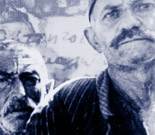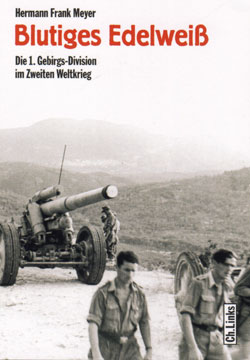 |
 |
 |
 |
 |
 |
 |
 |
||||||||||
|
|
|||||||||||||||||
Index Interview Review by the British author Richard Hargreaves |
The Edelweiss – worn on the cap and sleeve – was the insignia of the 1st Mountain-Division of the Wehrmacht, an elite troop resurrected in the Federal Army (Bundeswehr) eleven years after the end of the war under the same name by former leaders of the Wehrmacht. In these circles and in a post-war Comrades Association of the Mountain Troops (“Kameradenkreis der Gebirgstruppe”) the Edelweiss is regarded even now as a symbol of the “best German military tradition in war and peace”. In honouring this tradition, however, no one speaks about the war crimes committed in the Second World War. How did they come about, who gave the criminal orders, who followed them, why were such inhuman actions carried out? And how was it possible that after the war every single attempt to hold inquiries or even preliminary proceedings were flatly and scandalously turned down so that the perpetrators were never called to account? These are the fundamental questions that the author has raised and tried to answer. The author has researched not only the judicial proceedings held in Germany, Greece and Italy, the “South East General Trial” (Suedostgeneralprozess CaseVII), submitted to the American war trials in Nuremberg, but he has also studied all the relevant documents of the Wehrmacht. He went through documented memoirs of former mountain soldiers, he evaluated their private notes or diaries and he analyzed documents by military experts and historians writing after the war about the 1st Mountain-Division, published in Germany, Italy, Greece and the United Kingdom. His research led him to travel to ten countries and to consult more than two dozen archives. In Greece and in Albania he visited more than two hundred villages to see the real locations and to question contemporary witnesses. He was often the first German there since the Second World War. Although more than sixty years after the events, the villagers have not forgotten those atrocities. In his introduction, the author describes the creation of the 1st Mountain Division by the National Socialists and outlines the career of Herbert Lanz, General of the Mountain Troops, who was in charge of the Division fighting the Eastern campaign and who was later promoted to command the XXIInd Mountain-Army-Corps. He then describes the actions in the campaigns against Poland, France, Yugoslavia and the war of extermination against the Soviet Union (“The 1st Mountain Division in combat from September 1939 to March 1943”). Having sustained very heavy losses in its push into the Caucasus, the Division was transferred to the Balkans for some “freshening up” where the men were then involved in a major operation against the partisans in Montenegro(“Operation Black: Action against partisans in Montenegro, May/July 1943”). As the Axis powers expected an Allied invasion in South East Europe, the Division was then transferred to Greece and South Albania. Although there were only a few sporadic skirmishes with the Greek and Albanian partisans, the response was systematically to destroy the villages and to kill the inhabitants along the route of the advancing units (“The 1st Mountain Division in Thessaly, Epirus and South Albania”). General Lanz had meanwhile been appointed commander of an Army Corps in the Charkow sector where he apparently disregarded Hitler’s directives (“Interlude: Hubert Lanz appointed by Hitler to command an Army Corps – January/February 1943”). He only held this command for a few weeks. In July 1943 Lanz was given the task of creating the XXIInd Mountain-Army-Corps in Greece which would control the 1st Mountain-Division and the 104th Rifle-Division (“The new XXIInd Mountain-Army-Corps”). In this position, Lanz was responsible for disarming the Italian troops in Western Greece, the Ionian Islands and South Albania after the Italian capitulation in September 1943. The murdering of captured Italian soldiers and officers of the Division Acqui is one of the central themes of the book. On the basis of the number of victims, this is arguably one of the biggest massacers carried out by the Wehrmacht. Hundreds of books, treatises and articles have been written about it, but in a large majority of these publications, the writers have presented as facts their own assumptions and speculations about the events and the numbers of victims, so that false legends and myths have been created which the author exposes and corrects (“The disarmament of the Italian Army Corps, September-October 1943”). After the Italian retreat, Lieutenant Colonel Josef Salminger, a popular regimental commander, died of his wounds after a partisan attack. As “atonement measure” Lanz ordered that civilians should be massacred and whole villages robbed and burned to the ground. The commander of the right-wing Greek resistance group EDES, Colonel Napoleon Zervas, under pressure from the Germans, agreed to a “moratorium”. The author has uncovered a vast amount of documentation that has not been published before concerning the controversial question as to whether this was an act of collaboration which in fact contributed to the outbreak of the Greek civil war that lasted until 1949 (“Partisan war in Epirus and the “Gentlemen’s Agreement” between Germans and the EDES”). Once the EDES was seen to be holding back, the 1st Mountain-Division left Greece in November 1943 and was deployed in Montenegro and Serbia against Tito’s partisans and then moved on to disarm the Hungarians in the spring of 1944. Subsequently, the Division returned to Epirus, Macedonia and South Albania where it fought in two major operations against the leftwing partisan bands (the ELAS and others) and inflicted serious losses on them. After another transfer back to Serbia and Hungary, the Division suffered its highest losses in the battles near Belgrade and lake Balaton. At the end of the war it was stationed in Austria. Meanwhile, the XXIInd Mountain-Army-Corps continued in Epirus being in charge of a few Battalions and the 104th Rifle-Division. The latter operated near Agrinio with collaborating Greek Security Battalions („Tagmata Asfaleias“) who had been enlisted to participate in shooting hostages and in combating leftwing ELAS partisans. Meanwhile, the EDES commander Zervas flipped between the Germans and the British liaison officers (BLO), his main aim being to seize power in Greece after the war. This was also the period when the Jewish population was deported from Western Greece and Corfu, with the XXIInd Mountain-Army-Corps having its hand in this operation. (“The 1st Mountain Division as ‘fire brigade’ in South East Europe, deportation of Jews and retreat, November-May 1945”). The book ends with a chapter about the post war careers of the former officers of the Division and the Corps in the 1st Mountain-Division of the Bundeswehr (German Federal Army) and about the activities of the Comrades Association of the Mountain Troops (“Kameradenkreis der Gebirgstruppe”). |
          more pictures... |
|||||||||||||||
|
|||||||||||||||||
